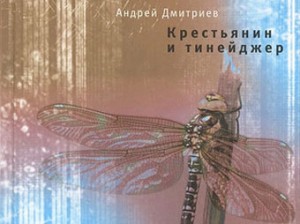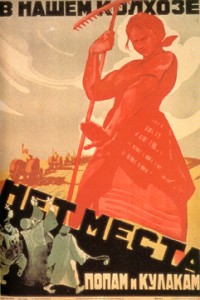
Andrei Viktorovich Dmitriev’s Крестьянин и тинейджер-The Peasant and the Teenager: A view of Russia in its last decade as a Republic of the U.S.S.R.
Recently I have been engaged in translating and studying certain novels that have won the Russian Booker Prize, an award presented yearly since 1992 to honor outstanding Russian fiction . With this exercise I seek to gain a broader understanding of contemporary Russian thought and culture. My primary interest is in how Russians today view their own history, especially that of the Revolution of 1917 and the Soviet period.
The two works I’ve looked at most recently serve to bookend this period: Казус Кукоцкого (Kazus Kukotskovo = ‘The Extraordinary Case of Kukotsky’), by Lyudmila Evgenyevna Ulitskaya, and Крестьянин и Тинейджер (Krest’yanin i Tinyedzhyer = ‘The Peasant and the Teenager’), by Andrei Viktorivich Dmitriev. In a recent post (‘Казус Кукоцкого’) I examined Ulitskaya’s novel as to how it portrays the Revolution and its aftermath, finding her views consistent with my own narrative of this period. Turning to Dmitriev’s ‘The Peasant and the Teenager,’ I was delighted to find not only a portrayal of Russia in the decisive last decade of the U.S.S.R., but one from the perspective of rural, ‘collective farm’ Russia.
 In addition to pointing to facts of life in Russia in the 1980’s that had become part of the Western story of the failure of Soviet central economic planning, the paragraphs I will present here in English translation highlight the problematic legacy of the collectiviation of agriculture—the crippling of peasant culture and the organization of food production as a state managed industry.
In addition to pointing to facts of life in Russia in the 1980’s that had become part of the Western story of the failure of Soviet central economic planning, the paragraphs I will present here in English translation highlight the problematic legacy of the collectiviation of agriculture—the crippling of peasant culture and the organization of food production as a state managed industry.
The following passage comes at the beginning of the novel. The first character introduced is, so far, given only one name—Panyukov. His history is tied to that of his friend, Vova, who is two years Panyukov’s junior. They grow up in a village near a collective farm, in neighboring cabins. Vova, neglected by his alchoholic parents, is essentially raised by Panykov’s mother, making he and Panyukov brothers in all but name:
Panyukov survived in Kandahar, and returned to Sagachi. He got work at a separator on a sovkhoz—a government farm—and waited for Vova, who had gone to war two years later. He did not want to remain on the farm, but to strike out for life in the city alone, without Vova, he dared not do. He waited for him and wrote him letters, relating everything as it happened: about the death of his grandma Zina (“I am looking after her cabin, and cleaning up there. You can decide yourself what to do with the cabin later”); and then about the divorce of his parents (“They separated, and both left Selikhnova, but who went where—no one knows. Neither left an address, and they did not leave anything for you, but that’s no big deal. It is too bad that the sovkhoz took your apartment in the three-story. As Igonin told it to me, you were always registered in our Sagachi, with your grandma Zina, and so you have no right to the apartment”).
Vova also survived, but was in no hurry to return. He knocked about for three months in the city—a year in another city; finding out for himself what’s here, what’s there. But he returned anyway, and gave a report: it’s the same everywhere—vouchers, waiting in lines, empty stores, filthy hostels, money not paid or paid over time: Get away from this place? —What for?
Vova settled in Sagachi, in his own cabin. No work could be found for him at the decaying sovkhoz. Panyukov worked, sort of, at the separator, but it was not enough to put butter on the table—the sovkhoz no longer paid wages. So he quit to churn his own butter. He and Vova decided to live together, and not just to get by, but to live large. They got three cows on loan, bought a sheep and pigs. They built a shed with cages for rabbits and fowl and dug new vegetable beds. Care of the animals was eventually taken over by Panyukov entirely, and Vova busied himself with their common garden and greenhouse. The cabins, which seemed to have never seen any repair, they repaired, as best they could, together.
. . . Vova’s parents usually had gotten grains, bread, tea and vodka at a store, potatoes were gathered in the fields of the sovkhoz at night. Panyukov’s mother, grandma Zina, and all who remained in Sagachi in that time, never kept animals and managed with gardens, getting bread, tea and grains from a mobile grocers. Milk was brought to Sagachi in a tanker from a farm near Selikhnova. Vova and Panyukov, though they were both country boys, familiar with gardens, and as school kids had been driven here and there on tractors, had no agricultural skill.
This sketches the outlines of tough times. In addition to the grievances listed by Vova concerning the state of the economy, there was the War in Afghanistan, in which young Russians were compelled to serve. Also mentioned is the trend, typical of modernizing societies, that sees the flight of youth from farm to city.
But much of this passage resonates with my understanding of the history of relations between those who work the land, and the state. Before, during and after the Revolution, the peasantry, as a class, proved problematic for Socialists and Marxists, on a theoretic as well as a practical level. The Peasants were not inherently revolutionary, and a revolution by and for the industrial working class was harder to justify in Russia, where the peasantry constituted a majority of the population. And after the Bolsheviks assumed command of the state there were the problems of how to exercise power in the countryside, and how to ensure a sufficient, reliable, cheap and constant supply of food for the cities.
The decisive response to these challenges came with Stalin’s ‘collectivization’ campaign. All farming resources, including land, were to be transferred to the state; these resources were divided among newly created “collective farms”—the Kolkhozi (Collective Farms), and Sovkhozi (Soviet Farms)—which were managed by the Communist Party apparatus. All peasants, and others whose work in any way supported the production and distribution of agricultural products, were assigned to any one of these farms.
The opposition of peasants who were stripped of their property and told where and how to work was fierce. The implementation of this policy essentially amounted to a war on the peasantry. The peasants lost; central economic planning and Communist Party management were brought to the farm.
But state planning and management of agriculture, as in industry, was often woefully inefficient, prone to corruption, and provided very little incentive for hard work and innovation. The early years of collectivization saw some of the worst famines in Russia’s history.
Even as the Communist Party improved on this system, food security was a continual struggle for the Soviet Union throughout its history. Riots triggered by changes in the supply or pricing of food were not unknown, and were dealt with brutally (see Samuel H. Baron, Bloody Saturday in the Soviet Union). Dealing with this problem was central to the reform efforts of Nikita Khrushchev in the late 19950’s, early 60’s. For Mikhail Gorbachev, an important impetus for his ‘Perestroika’ (“Rebuilding”) reforms was the need to deal with the fact that the U.S.S.R. could no longer afford to make up for deficiencies in food production by buying food, especially massive quantities of grain, from abroad. What had been for the West an oil “crisis” in the 1970’s, was for the Soviet Union a boom, but by the time Gorbachev becomes General Secretary of the Party in 1985 , those days were done. By the early 1990’s Gorbachev even begins to flirt with the idea of privatizing agricultural resources—granting shares of each collective to its workers to give them a greater stake in the productivity of the farm.

This passage from Крестьянин и Тинейджер nicely highlights the legacy of collectivization and the subordination of farming resources to centralized, state control: agricultural workers were dependent on the same distribution networks for getting their food as urban dwellers (unless they wanted to risk stealing from the collective farm); even farm workers relied on their own private plots to ensure an adequate supply of food for themselves and their families; the collectives, described here as “decayed,” had even gotten to the point where they were no longer able to pay wages to their workers. The most striking point to me is the last one—that those who grew up and worked on the farms had no agricultural skill. It seems to me that the collectivization campaign of the 1930’s had effectively destroyed peasant culture, and the new culture of the collective was not enough to replace the lost knowledge of how to farm that had accumulated in the peasant consciousness over centuries. It appears from this passage that this loss continued to haunt Russia a half century later.
© 2013, John Dougherty. All rights reserved

